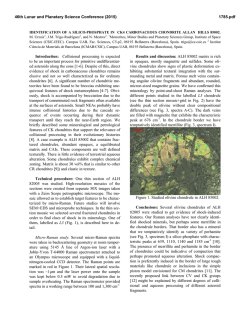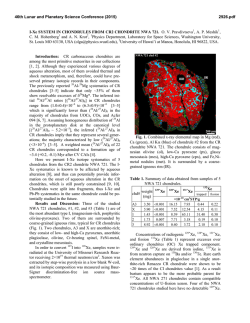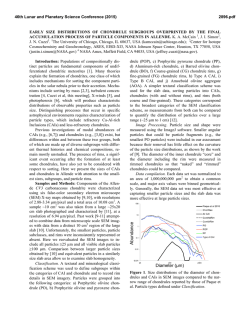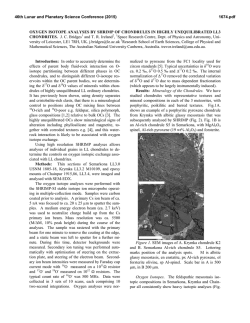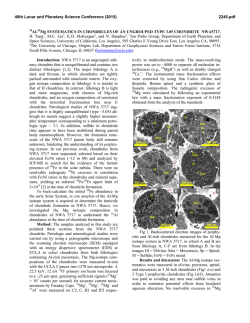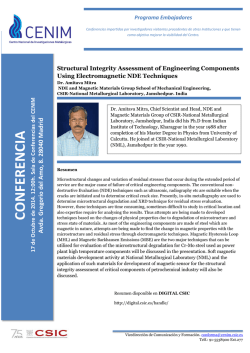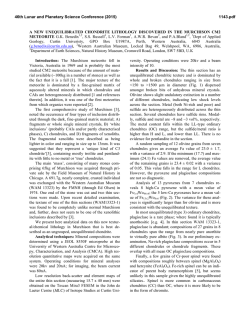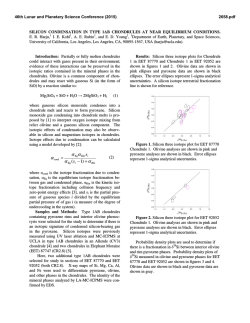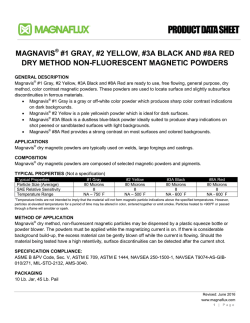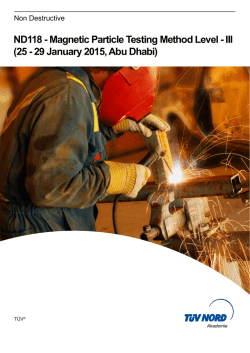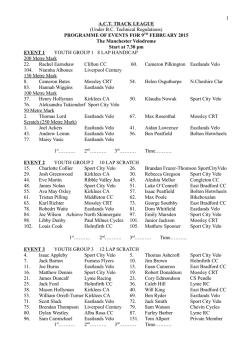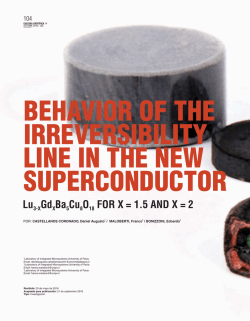
MAGNETIC FIELDS IN THE LATE
46th Lunar and Planetary Science Conference (2015) 1587.pdf MAGNETIC FIELDS IN THE LATE-STAGE SOLAR NEBULA RECORDED IN CR CHONDRITES. R. R. Fu1, B. P. Weiss1, D. L. Schrader2. 1Department of Earth, Atmospheric, and Planetary Sciences, Massachusetts Institute of Technology, Cambridge, MA, USA ([email protected]). 2National Museum of Natural History, Washington DC 20560. Introduction: Magnetic fields are hypothesized to have played a central role in the formation of planetary systems. Astronomical observations indicate that nebular gas, totaling ~1% of the stellar mass, accretes onto the central star during the 3-5 million year (My) lifetime of protoplanetary disks [1, 2]. This rapid infall of gas requires an efficient mechanism of angular momentum redistribution. Magnetic fields, partially coupled to the nebular gas due to its weakly ionized state, may facilitate angular momentum transport by enhancing turbulent viscosity in the disk or via magnetocentrifugal winds [3, 4]. Direct observations of protoplanetary disks cannot currently infer the strength of magnetic fields in the planet-forming regions [5]. However, paleomagnetic experiments on chondrules extracted from primitive meteorites may constrain the intensities of magnetic fields in the protosolar accretion disk. A recent paleomagnetic study indicated that dusty olivine-bearing chondrules extracted from the Semarkona LL chondrite formed in a magnetic field of 54 ± 21 µT at approximately 2.0-2.5 My after calcium aluminum-rich inclusions (CAIs) [6]. These field intensities are lower than those predicted for chondrule formation in x-winds or nebular lightning and, instead, favor the nebular shock or planetesimal collision models. Furthermore, magnetic fields with such intensities are sufficient to mediate the transport of mass and angular momentum in the solar nebula. Lower observed gas accretion rates in late-stage protoplanetary disks may imply the decay of magnetic fields driving angular momentum transport [7]. Measurements of the strength of these late magnetic fields would constrain the lifetime of protoplanetary disks and the evolution of their large-scale dynamics. Here we present results from paleomagnetic experiments on individual chondrules extracted from LAP 02342, a highly primitive CR2 chondrite. Al-Mg dating has shown that more than 70% of CR chondrules formed >3.0 My after CAIs [8] while Pb-Pb measurements yield a mean age of 3.6-4.1 My after CAIs, depending on the age adopted for the latter [9]. These ages are ~1.5 My after the formation of Semarkona chondrules and coincide with the expected lifetime of the protosolar disk. LAP 02342 is a highly primitive meteorite: Although chondrules may have acquired a remanent magnetization recording nebular magnetic field during cooling in the solar nebula, a variety of subsequent processes may have led to the partial or complete loss of the preaccretional remanence. Such processes on the meteorite parent body include thermal metamorphism, aqueous alteration, and impact shock, while terrestrial mechanisms of remagnetization include weathering and exposure to strong artificial magnetic fields such as those generated by hand magnets. Fig. 1. Equal area stereonet projection of bulk sample and chondrule magnetization directions in LAP 02342 with maximum angular deviation (MAD) uncertainties. Subsamples of the same chondrule are plotted with the same color. One subsample from chondrules C1 and C2 did not carry any identifiable magnetization component. Black star and circle are the mean direction and 95% confidence interval of the FC1 overprint found in bulk samples near the fusion crust. The exsolution of Ni-rich phases from primodial Ni-poor metal is a sensitive indicator of parent body metamorphism [10]. Only a small fraction of chondrule interior metal grains from LAP 02342 exhibit exolution textures, implying a lower degree of thermal metamorphism than Semarkona and temperatures of less than ~200˚C [11, 12]. Electron microscopy shows that metal grains from the interiors of LAP 02342 chondrules are free of secondary phases, such as magnetite, that are produced during aqueous alteration or terrestrial weathering [11]. These results are consistent with the classification of LAP 02342 as weathering grade A and with compositional studies that suggest a low degree of parent body alteration [13]. Finally, our optical microscopy of an LAP 02342 thin section showed a lack of shock features such as undulatory extinction in olivine, implying that this meteorite was 46th Lunar and Planetary Science Conference (2015) never shocked up to 5 GPa [14]. Based on these studies, we conclude that chondrules from LAP 02342 have escaped all post-accretional remagnetization processes likely to have removed a pre-accretional remanent magnetization. Bulk samples confirm that LAP 02342 escaped remagnetization: We measured 17 bulk (i.e., mixed chondrule and matrix) samples to identify any postaccretional magnetic overprints. All samples used in this study were from extracted from a 15 mm × 10 mm × 130 µm thick section of LAP 02342 provided by the Johnson Space Center and were mutually oriented to <5˚ accuracy. All bulk samples were measured using a 2G Superconducting Rock Magnetometer (SRM) and subjected to stepwise alternating field (AF) demagnetization up to 145 mT. Ten out of eleven bulk samples from ≤1 mm from the fusion crust carry a unidirectional component of magnetization (the FC1 component; Fig. 1). In samples bearing fusion crust material, the FC1 component is blocked from 0 to up to >145 mT, suggesting a total thermoremanent magnetization (TRM). The FC1 component is blocked up to lower coercivities (<72 mT) in samples located between 0.5 and 1.0 mm from the fusion crust. The FC1 or any other unidirectional magnetization is absent from all samples from the deeper interior. We conclude that the FC1 magnetization is a TRM acquired during atmospheric entry and that samples >1 mm from the fusion crust escaped all magnetic overprinting processes post-dating the assembly of the meteorite. Given the low degree metamorphism experienced by LAP 02342 on its parent body, the absence of a unidirectional overprint suggests that the CR parent body did not harbor a strong core dynamo during the time period of metamorphism. Formation of CR chondrules occurred in a weak (<15 µT) magnetic field: We recovered paleomagnetic data from eight samples extracted from the interiors of three chondrules (two porphyritic olivine, one cryptocrystalline). We subjected five samples to stepwise AF demagnetization up to 290 mT while the remaining samples underwent stepwise thermal demagnetization to 624˚C in a oxygen fugacity-controlled atmosphere to mitigate the effects of sample alteration [15]. Due to their weak magnetic moments, seven out of eight chondrule samples were measured using the MIT SQUID Microscope [6] while one sample was measured on the SRM. All chondrules samples were located at least 2.7 mm from the fusion crust; as such, none were affected by the FC1 overprint. Chondrules cooling in sufficiently strong nebular magnetic fields are expected to acquire a unidirectional TRM [16]. Although all three chondrules had at least 1587.pdf two subsamples, no chondrule carried a unidirectional component of magnetization [Fig. 1]. To provide an upper bound to the magnetic field in which our chondrule samples may have formed, we performed anhysteretic remanent magnetization (ARM) acquisition experiments using a 290 mT AC field on two subsamples of chondrule C1. These samples appear to have retained a unidirectional magnetization for bias field of 7.5 µT, but failed to do so to for a bias field of 5 µT. Accounting for the two-fold probablistic reduction in magnetic field intensity due to chondrule rotation [6], we conclude that CR chondrules formed in a nebular magnetic field weaker than ~15 µT. Weak paleofields suggest decay of the solar nebula by 3.6-4.1 My after CAIs: The <15 µT paleointensities of the CR chondrule formation environment are significantly lower than the 54 ± 21 µT value derived from measurements of Semarkona [6]. Assuming that chondrules from both meteorite groups originate from the location of the modern asteroid belt (2-3.3 AU), this implies that the magnetic field intensity in the solar nebula had declined by a factor of >3 by 3.6-4.1 My after CAIs. This decay in the magnetic field intensity may be due to significant dissipation of the nebula by this time, which is consistent with the observed age range of protoplanetary disks [1]. A second possibility is that the CR chondrule formation mechanism only weakly amplified background fields compared to that of Semarkona chondrules. Ongoing experiments will verify the absence of pre-accretional magnetization in a larger set of chondrules. Finally, TRM acquisition experiments may provide a significantly lower limit on the maximum paleointensity in the CR chondrule formation region. References: [1] Haisch, K. E. et al. (2001) Astrophys. J. Lett. 553, L153. [2] Hartmann, L. (1998) Astrophys. J. 495, 385. [3] Balbus, S. A. and Hawley, J. F. (1998) Rev. Mod. Phys. 70, 1. [4] Bai, X.-N. and J. M. Stone (2013) Astrophys. J. 769, 76. [5] Crutcher, R. M. (2012) Ann. Rev. Astron. Astrophys. 50, 29. [6] Fu, R. R. et al. (2014) Science 346, 1089. [7] Bai, X.-N. and Goodman, J. (2009) Astrophys. J. 701-737. [8] Hutcheon, I. D. et al. (2009) Geochim. Cosmochim. Acta 73, 5080. [9] Schrader, D. L. et al. (2013) 76th Meeting of Meteoritical Society, 5141. [10] Kimura, M. et al. (2008) Meteor. Planet. Sci. 43, 1161. [11] Briani, G. et al. (2013) Geochim. Cosmochim. Acta 122, 267. [12] Cody, G. D. et al. (2008) Earth Planet. Sci. Lett. 272, 446. [13] Wasson, J. T. and Rubin, A. E. (2009) Geochim. Cosmochim. Acta 73, 1436. [14] Stöffler, D. et al. (1991) Geochim. Cosmochim. Acta 55, 3845. [15] Suavet, C. et al. (2014) Geochem. Geophy. Geosy. 15. [16] Fu, R. R. (2014) Earth Planet. Sci. Lett. 404, 54.
© Copyright 2026
